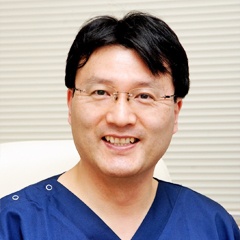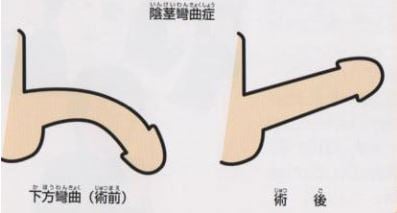
このページの監修医師

このページの監修医師
日本語ページはこちら
陰茎湾曲症の原因と手術について
There are many important blood vessels and nerves in the penis. To avoid damaging them during surgery, microscope is used to carefully preserve blood vessels and nerves. This allows us to operate on a smaller area and with minimal scars. Recurrence prevention techniques can also be performed in our clinic.
These techniques are performed exclusively at our clinic.
■The primary surgeon is a super microsurgeon.
Our primary doctor is a microsurgery specialist who also performs super microsurgery (anastomosis of lymphatic vessels with the thinnest diameter of 0.3 mm). This enables us to perform safer and reliable surgeries.
*We do not provide treatment for cosmetic purposes, so the cost of treatment is subject to a medical expense deduction.
Penile curvature is a disease in which the penis curves during erection. The penis is made up of three cylinders that fill with blood to create an erection. The corpus spongiosum, located at the bottom of the penis surrounding the urethra. Above that are two corpus cavernosum on either side.
Congenital penile curvature (present from birth) is an imbalance in the development of these three cylinders, causing the penis to bend when erect.
Mild curvature is not a problem, but surgery is considered when it interferes with sexual intercourse.
Specifically, pain during and after sexual intercourse, difficulty inserting the penis, if insertion is possible the penis may easily fall out, or there are restrictions on sexual positions.
There are two types of penile curvature disorders: congenital and acquired. Congenital is present at birth and caused by an imbalance in the development of the penile tissue. This results in an increased curvature of the penis as it grows.
Acquired factors such as penile fibrosis (Peyronie's disease), are caused by the formation of scar tissues called plaque under the skin in thick elastic membrane called the tunica albuginea.
Causes of penile curvature include entrapment of the urethral due to hypospadias ( a birth defect in boys in which the opening of the urethra is not located at the tip of the penis) and entrapment of the urethra in the absence of hypospadias. Penile curvature is frequently associated with an imbalance in the development of the penile corpus cavernosum and penile corpus spongiosum.
Causes of penile curvature include entrapment of the urethral due to hypospadias ( a birth defect in boys in which the opening of the urethra is not located at the tip of the penis) and entrapment of the urethra in the absence of hypospadias. Penile curvature is frequently associated with an imbalance in the development of the penile corpus cavernosum and penile corpus spongiosum.
Difficulty in insertion, easy withdrawal even when insertion is possible, pain for a partner, and limited positioning during intercourse are all factors that may cause sexual disorders.
Psychogenic ED may occur due to anxiety about not being able to have sexual intercourse with a partner.
Penile curvature is a disease in which the penis curves during erection. The penis is made up of three sponges which fill with blood during an erection. The corpus spongiosum, located at the bottom of the penis surrounding the urethra. Above that are two corpus cavernosum on either side.
Congenital penile curvature (present at birth ) is caused by an imbalance in the development of the corpus spongiosum and corpus cavernosum.
The cause of Peyronie's disease is unknown, but scar tissues called plaque forms plaque under the skin in thick elastic membrane called the tunica albuginea resulting in curvature and penile shortening. In addition, trauma to the penis can cause the development of scar tissues, resulting in the same symptoms as Peyronie's disease.
We will ask about the time of onset of the disease, presence or absence of penile sensory abnormality, degree of erectile hardness, and presence or absence of hypospadias. You will be asked to cut your pubic hair short at home and take pictures (cell phone, digital camera, Polaroid picture, etc.) of your penis from above and from the side when fully erect, and bring them with you. If you do not have a photo, we will ask you to describe the direction and degree of curvature with a drawing or your finger, then we will confirm it later with a photo.
During the examination, we will also palpate for the presence of scar tissues.. If a lump is present, Peyronie's disease is suspected.

Since congenital penile curvature basically does not shorten the penis, surgery is performed to sew and shrink the tunica albuginea on the opposite side of the flexion. To prevent recurrence and instability (wobble), 5 stitches are used in one location at the base or center of the penis. In cases of hypospadias or penile fibrosis with penile shortening, autologous veins or autologous dermis may be transplanted.
Basically, surgery is performed when the patient has sexual problems (difficult insertion, easy withdrawal, painful intercourse, and restricted positioning). In our experience, patients with a downward curvature are more likely to have these problems.
If the curvature is not only in one direction, but also in two or three directions, multiple plastic surgeries are required.
Congenital penile curvature may change in degree of curvature during the growth period, therefore, surgery is performed from high school age and above. If surgery is performed too early, it will change with growth and require additional surgery.
In order to determine the specific surgical plan, prostaglandin E1 is injected into the corpus cavernosum to measure erectile hardness, the angle of penile curvature, and the length of the penis. The prostaglandin E1 is injected into the corpus cavernosum with a needle as thin as a tuberculin needle, so it is not painful. After the injection, the patient will be stimulated sexually, and when the erection reaches its maximum, photographs will be taken and measurements will be made. If the hardness of the erection is extremely low, the surgical procedure may be different.
At home, cut your pubic hair cut short and take photographs (cell phone, digital camera, Polaroid photo, etc.) from above and from the side at the time of full erection. The examination with prostaglandin E1 penile corpuscle injection may not be necessary if these photographs are provided.
Other preoperative examinations include a blood test for infection.
Anesthesia is administered at the base of the penis. Since it is a long-acting type of anesthesia, a 3-hour surgery can be performed.
The artificial erection method is a drug-induced erection, so the base of the penis is not tightly constricted by threads or other means, and there is no nerve damage. Since the erection is close to natural erection due to the inflow of blood by the drug, preoperative and immediate postoperative evaluations can be performed more accurately, and the patient himself can confirm the natural erection state.
The skin incision is a small wound of approximately 2 cm in one location, and important nerves and blood vessels are carefully handled using a microscope.
The membrane of the corpus cavernosum (tunica albuginea) is sutured with a dissolvable thread to minimize the use of a non-elastic thread for adhesion. The knot is buried and is reinforced with a dissolvable thread. Since the tunica albuginea is fused, recurrence is almost non-existent.
Surgery time is about 1 hour and 30 minutes for a single site; for two or more sites, it may take 2 to 3 hours, depending on the direction and angle of curvature.
On the day of your visit, the doctor will give you a detailed explanation about the results of the preoperative examination and the surgery.
You will be taken to the operating room and the surgery will begin. The surgery will last from 1 hour and 30 minutes to 2 hours, or 3 hours at the most, depending on the number of sites to be performed on.
During the surgery, you will be able to talk with the doctor. You will also be asked to check the shape before the surgery is completed. After confirmation, the surgery will be completed.
After the surgery, you will be sent home after an explanation of post-operative precautions.
We perform one-day surgery under local anesthesia using the suturing method (Plication method) for high school students and ages above.
You can walk home immediately after the surgery.
Things to keep in mind when choosing a hospital for surgery
This surgery is also performed by cosmetic surgeons, but care should be taken to avoid complications (nerve damage, blood flow disorders, postoperative deformities) and other problems that can occur if the surgery is performed by an inexperienced surgeon.
The surgery must be performed by an experienced surgeon with careful technique.
This is essentially a urologic disease. To prevent postoperative problems, we recommend that you choose a urologist who specializes in sexual function.
At our clinic, diagnosis and treatment are performed by Professor Nagao of Toho University, who is the President of the Japanese Society for Sexual Function and a specialist in both the Japanese Urological Association and the Japanese Society of Plastic Surgery.
*As we do not provide treatment for cosmetic purposes, the cost of treatment is subject to a medical expense deduction.
Cost for initial consultation (tax included)
| Medical examination (initial consultation) | US$550 |
|---|
| ventral curvature | US$11,000 |
|---|---|
| lateral curvature | US$11,000 |
| Medical certificate | US$200/page |
 What symptoms are used to diagnose penile curvature?
What symptoms are used to diagnose penile curvature?
We will ask about the time of onset, presence or absence of penile lumps, degree of erectile hardness, and presence or absence of hypospadias. We will also check for lumps by palpation (suspicion of Peyronie's disease).
 Are there any problems associated with penile curvature?
Are there any problems associated with penile curvature?
It can cause infertility in men and a poor relationship with your partner due to sexual dysfunction (difficulty inserting the penis, easy withdrawal after insertion, gential pain etc.).
 How much curvature is needed to be considered for surgery?
How much curvature is needed to be considered for surgery?
Surgery can be performed when the patient is experiencing or anticipating difficulty with intercourse. For bending to the left/right or upward, surgery is often performed at curvature of 30 degrees, and for downward curvature, surgery may be performed at as little as 15 degrees. Downward curvature is more likely to result in gential pain of older males.
 When should I have my child undergo surgery for penile curvature?
When should I have my child undergo surgery for penile curvature?
In the case of congenital penile curvature, the degree of curvature may change during growth. Even if surgery is performed early, if the curvature changes as the child grows, additional surgery may be necessary.
 Are there any restrictions on daily activities after penis curvature surgery?
Are there any restrictions on daily activities after penis curvature surgery?
Showering is allowed the next day with protective tape applied, and the wound is not allowed to get wet until after one week of the surgery. Drinking is allowed after two weeks, and masturbation and sexual activity will be allowed after two months when the surgical site is stabilized. During the two months before the surgical site is stabilized, an elastic bandage (thick bandage) should be wrapped to prevent the thread from loosening even if the patient has an erection.
 How much is the cost of penile curvature surgery?
How much is the cost of penile curvature surgery?
The cost of the surgery is 550,000 yen for one site correction and 880,000 yen for two surgery sites. In addition, an initial consultation fee, examination fee, and anesthesia fee will be charged.
〒104-0061 東京都中央区銀座2-8-19 FPG links GINZA 6F

永尾 光一 先生
東邦大学 医学部教授(泌尿器科学講座)
東邦大学医療センター大森病院 リプロダクションセンター
東邦大学医療センター大森病院 尿路再建(泌尿器科・形成外科)センター長
昭和大学にて形成外科学を8年間専攻。その後、東邦大学で泌尿器科学を専攻し、形成外科・泌尿器科両方の診療科部長を経験する(2つの基本領域専門医を取得)。得意分野はマイクロサージャリーをはじめとする生殖医学領域の形成外科的手術。泌尿器科医の枠を超えた細やかな手術手技と丁寧な診察で、様々な悩みを抱える患者さんから高い信頼と評価を得ている。
所属医療機関
〒104-0061 東京都中央区銀座2-8-19 FPG links GINZA 6F